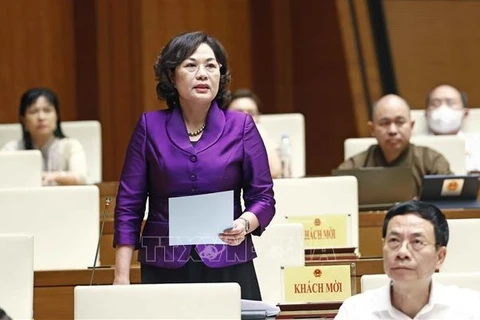Hanoi (VNS/VNA) - The State Bank of Vietnam (SBV) has so far this year sold about 12-13 billion USD to stabilise the domestic forex market, according to Viet Dragon Securities Corporation (VDSC).
The value was equal to some 11% of Vietnam’s foreign exchange reserves. The country’s foreign exchange reserves are currently at more than 100 billion USD, equal to 3.1 months of imports, and are forecast to keep rising. The value, which is four times higher than in 2015, is expected to be an important buffer to stabilise the domestic forex market and help the country’s economy withstand external shocks.
According to VDSC, the SBV’s move was aimed to restrict the devaluation of the Vietnamese dong, reduce pressure on the foreign exchange rate and balance the supply and demand of the greenback in the domestic forex market.
In the context that most currencies have fallen significantly against the US dollar after the Federal Reserve raised interest rates, the dong has only weakened against the US dollar by around 2% so far this year, which shows the dong is relatively stable and listed among currencies with the lowest devaluation in the Asia-Pacific region.
According to VDSC, despite several net withdrawals of the dong through the sale of the dollar and T-bills, domestic demand for the greenback remains strong. It has shown no signs of cooling down as the interest rate of dollar loans in the interbank market continues to increase and the rate gap between dollar and dong loans in the interbank market also keeps rising.
In the short term, VDSC expects the SBV will continue to use the foreign exchange reserves and the T-bill sales to withdraw the dong in the open market operation (OMO) to reduce the dong liquidity in the banking system so as to curb pressure on the exchange rate.
VDSC forecast the domestic exchange rate might be under higher pressure at year-end. However, it still expects the dong to depreciate only about 2.0-2.5% in 2022, remaining unchanged against its previous forecast.
Pham Chi Quang, deputy head of the SBV’s currency policy department, last month affirmed that with foreign exchange reserves of more than 100 billion USD, the central bank will continue to sell its foreign currency to stabilise the market.
The SBV will continue to manage the currency exchange rate with flexibility to absorb external shocks, help stabilise the macro economy and control inflation, according to Quang./.
The value was equal to some 11% of Vietnam’s foreign exchange reserves. The country’s foreign exchange reserves are currently at more than 100 billion USD, equal to 3.1 months of imports, and are forecast to keep rising. The value, which is four times higher than in 2015, is expected to be an important buffer to stabilise the domestic forex market and help the country’s economy withstand external shocks.
According to VDSC, the SBV’s move was aimed to restrict the devaluation of the Vietnamese dong, reduce pressure on the foreign exchange rate and balance the supply and demand of the greenback in the domestic forex market.
In the context that most currencies have fallen significantly against the US dollar after the Federal Reserve raised interest rates, the dong has only weakened against the US dollar by around 2% so far this year, which shows the dong is relatively stable and listed among currencies with the lowest devaluation in the Asia-Pacific region.
According to VDSC, despite several net withdrawals of the dong through the sale of the dollar and T-bills, domestic demand for the greenback remains strong. It has shown no signs of cooling down as the interest rate of dollar loans in the interbank market continues to increase and the rate gap between dollar and dong loans in the interbank market also keeps rising.
In the short term, VDSC expects the SBV will continue to use the foreign exchange reserves and the T-bill sales to withdraw the dong in the open market operation (OMO) to reduce the dong liquidity in the banking system so as to curb pressure on the exchange rate.
VDSC forecast the domestic exchange rate might be under higher pressure at year-end. However, it still expects the dong to depreciate only about 2.0-2.5% in 2022, remaining unchanged against its previous forecast.
Pham Chi Quang, deputy head of the SBV’s currency policy department, last month affirmed that with foreign exchange reserves of more than 100 billion USD, the central bank will continue to sell its foreign currency to stabilise the market.
The SBV will continue to manage the currency exchange rate with flexibility to absorb external shocks, help stabilise the macro economy and control inflation, according to Quang./.
VNA























